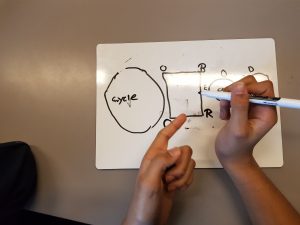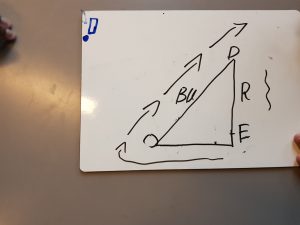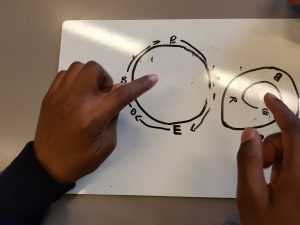Narrative Shapes. Lesson Six: “The Maker”

From a focus on six word short stories and classification the Year 6 class moved on to narrative sequencing in a film, considering the story mountain as a model and narrative shape.
Narrative sequencing in Let’s Think in English involves:
“…the ability to sequence and re-sequence events to create narratives with different purposes and effects. It involves being able to manipulate component parts of that narrative to create additional, perhaps multiple, meanings and layers of complexity.”
Pupils study a short film called The Maker by Zealous Creative. See:
https://www.youtube.com/watch?v=YDXOioU_OKM
We start the lesson by interfering with text by playing the soundtrack of the opening of the film with the accompanying images hidden. Pupils are asked first to consider changes in tone and then speculate on the characters and setting before linking these speculations with evidence. It is remarkable how accurate the pupils’ speculations often are with suggestions of one character due to the lack of dialogue and suggestions of frantic action taking place indoors due to the shuffling sounds.
Once hooked in and with their own initial narrative created, pupils watched the film. There were gasps as the strange protagonist appeared. As the film reached its conclusion, pupils spontaneously broke into conversation as they discussed their understanding and established a clear narrative.
With the pupils now hooked, we explored an established narrative pattern model for the pupils to apply and review. Pupils are presented with the story mountain model for narratives earlier in their academic career, but are they provided with an opportunity to critically evaluate the model?
I began by asking the pupils to define the 5 stages in their groups: exposition, build up, problem, resolution and ending. The feedback from the groups suggests the pupils were familiar with the stages. I provided an opportunity for them to apply the stages to a narrative they are familiar with. They were studying David Almond’s “The Savage” in class and I invited them in their groups to identify the 5 stages in this narrative. Through feedback it was clear they had a shared understanding of the application of the 5 stages in “The Savage”.
I then invited them to apply the stages to a new text: “The Maker”. In their groups they discussed the possibilities, but while listening to the different groups it became clear there were differences of opinion regarding the problem and ending. In feedback I focused the discussion on this difference of opinion. We quickly established that the opening is when the rabbit first appears on the screen although a caveat is raised of how we read the opening differently when we’ve reached the end of the film. The build-up is seen as the rabbit’s attempts to bring its creation to life. The problem is viewed in different ways with some groups identifying it as how he might bring his creation to life while others argued the problem is the passing of time. I encouraged them to consider the reasoning behind the alternative positions: “Why might the other group argue that X is the problem?”. Once they considered both positions they are willing to accept both as inter-connected problems. They also discussed the ending; while they agree the film has an end point they suggest the narrative doesn’t and appeared to be repeating itself.
I drew the story mountain shape on the board and discussed why the problem is placed at the top. The pupils remarked because “it goes up”. I ask them what is “it”? The instant response was “the storyline”. I invited them to return to their groups and consider this further. Why is the problem at the top of the story mountain? And why do the lines slope? This appeared to provide a desirable difficulty; pupils were engaged but initially puzzled and they shift from thinking to reasoning.
Responses from one group explained the problem is at the top as this is often the highest point of tension and engagement and the lines and their slope reflect rising and falling tension. This appeared to be plausible to the other groups, but I felt they needed time to explore the suggested idea so I invited them to return to their groups to consider this further. As discussed before it is crucial pupils are encouraged not just to listen but to critically evaluate the ideas being shared.
I asked the class if the story mountain is the best shape for “The Maker”. Their immediate response was no. I challenged them for an alternative and again, almost immediately, a circle is suggested as it has the same start and end point. I challenged them again, to return to their groups and see if they could suggest an improvement on the circle. As expected, they swiftly found an improvement by suggesting an oval. We discussed why an oval might be an improvement and they justified the choice as it captures “the increasing tension” better than a circle.
I then set the groups the challenge to think of the most appropriate shape they can for “The Maker’s” narrative. Importantly the pupils are not set a task where the teacher is expecting a particular set response. Having designed the lesson and taught and observed it many times, I was aware of the likely possible responses but each pupil and group were given the freedom to assemble their own ideas. The images below show the range of shapes the pupils suggested for “The Maker”:
However, it is not just the idea that is important but the reasoning behind the idea and how this is evidenced with relation to the film. As mentioned in previous posts, the order of feedback is important in Let’s Think in English lessons. We attempt to take feedback in ascending order of difficulty of concept so pupils may build their understanding in stages. For example, to start with the cylinder shape would be conceptually too big a jump for some pupils as an initial point for discussion. However, all the pupils are able to consider why for example the semi-circle might be more reflective of the narrative with its sudden downturn in tension than an oval. By considering the best order of feedback all responses add value to the discussion and scaffold levels of increasing difficulty.
With the structure explored, the pupils considered the implications of the narrative and who the Maker might be. The inclusion of “might” is important as it enabled pupils to explore a range of possibilities rather than settling upon their first thoughts. Suggestions abounded with the first rabbit, the book, the violin, the music and a God-like figure all proposed. Pupils started to pose their own questions as they became submerged in the texts: Could the cycle be broken? If so, how?
Once more differing positions were adopted and reviewed. 7 LTE lessons in the class have moved beyond the desire to be right or indeed to provide a response for the teacher to approve. The pupils are now interested in enquiry and will often explain the merits of an opposing position before reaffirming their own. They no longer look at me exclusively as they speak but are starting to see their audience as the classroom community.
The lesson drew to a close with the end of the school day. 15 pupils unprompted approached me on the way out offering further thoughts and left the room discussing aspects of the film. “The Maker” and the discussions provoked continue to form and strengthen after the lesson. The pupils do not leave the room with a single nugget of knowledge or a fact to prove they’ve all understood the text, but they’ve made meaning of a text together by fusing their shared knowledge and skills and leave the classroom still making meaning.









This Post Has 0 Comments